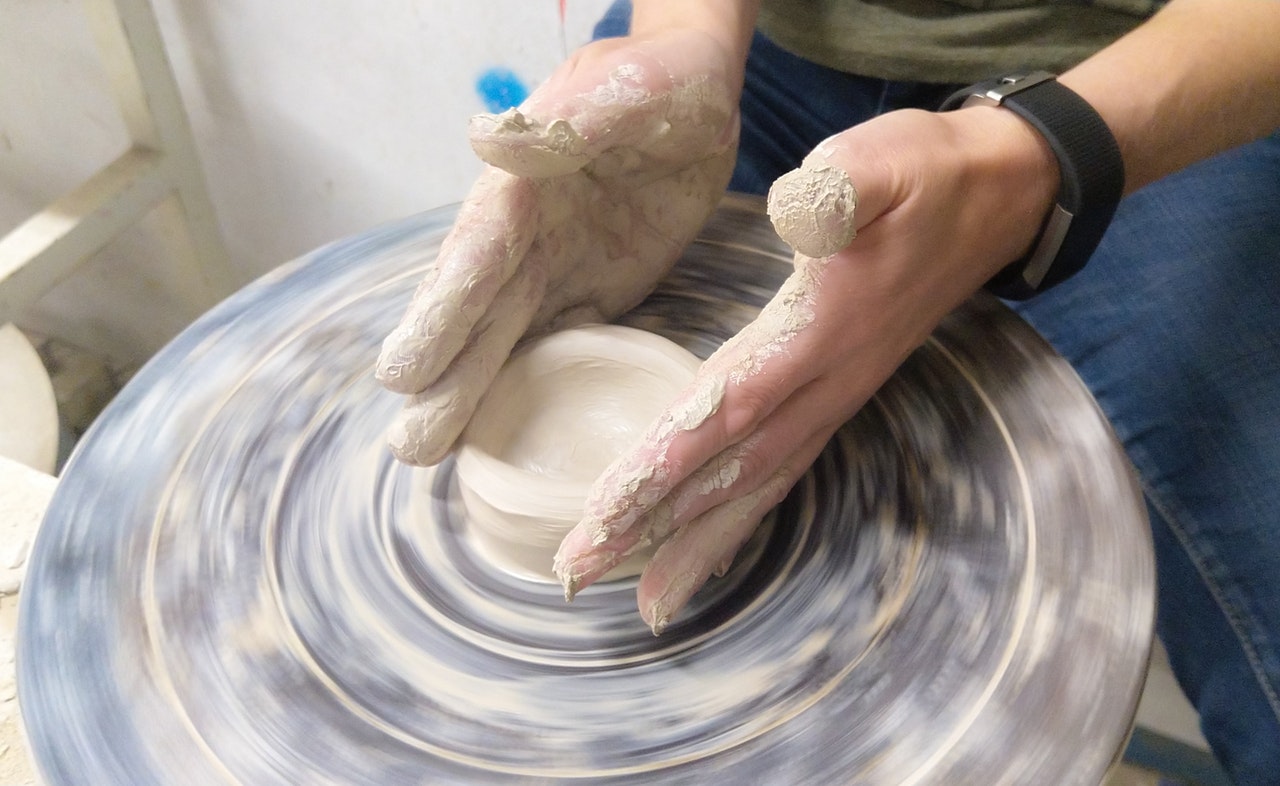Making pottery is one of the oldest things that shaped our lives. In fact, it’s so old that the oldest discovered piece of pottery is around 10,000 years old!
That being said, how pottery is made has dramatically evolved over the years. Turning pottery from simply fulfilling a use to an actual art where the potter creates his pieces with focus and passion.
Read on to know how pottery is made from the soft clay to the astonishing pottery pieces that live for years.
Picking The Right Clay
A crucial part of making pottery is choosing the right clay. Different kinds of clay have different uses and requirements. For example, the three most commonly used types of clay at the moment are earthenware, stoneware, and porcelain. Each with its specific characteristics and unique uses.
Every type of clay is useful and perfect for a specific use and it’s important to know what each clay excels at.
Earthenware
One of the easiest clays to work with as a beginner looking into hand building or throwing. Earthenware is a Low-Fire clay which means that it’s easier to crack than higher-fire clays. That’s why earthenware pottery is almost always made thicker than other kinds of clay.
It’s also known to be very porous which makes it preferable for outdoor pottery. Nevertheless, Earthenware can also be used for food and drink by simply glazing it which strengthens it and allows it to safely contain edibles.
Stoneware
Seen by many as the affordable alternative to the high-end porcelain. Stoneware is a mid-fire to high-fire clay. Meaning that it’s more durable than earthenware.
Most of the time you’ll see it in mugs, plates, and dinnerware in general. It can also be exposed to heat or used in the microwave safely after it’s fully finished.
Stoneware is a gritty clay that’s more forgiving than porcelain if you’re a beginner. Making it a great choice for practice before you start working on harder, more expensive clays.
Porcelain
Porcelain is the most valuable clay compared to all others. Porcelain is a mid-fire to high-fire clay.
Porcelain can be very thin yet durable. Moreover, due to its thinness, it can appear translucent around the edges. It’s water-tight and doesn’t stick, making it a great choice for high-end dinnerware.
True Porcelain is aimed at more professional potters due to the fact that it’s harder to work with. For example, if the clay deflates it would be very hard to shape back again.
Shaping the Pottery
Shaping the pottery is where the potter’s true skill and art shine. You can shape the clay into beautiful pottery either by hand building or by using a pottery wheel, also known as throwing.
Throwing
While throwing is indeed a challenging technique at first. In time, you’ll be able to complete numerous smooth and beautiful pieces efficiently with less effort.
The first thing to consider when throwing is what kind of pottery wheel you’re looking to use. Beginners usually incline towards electric pottery wheels as they save the focus needed to coordinate between shaping the clay and turning the wheel simultaneously.
Nevertheless, manual pottery wheels give you more control over the speed of the wheel. The speed of the wheel can be controlled using your foot. That can have better results among professional potters.
Regardless of whether you choose manual or electric wheels. The method of how you shape your clay stays pretty much the same. Let me briefly share with you one of the ways of how the clay is thrown.
- Place the clay in the center of the wheel
- Make sure it remains centered throughout the process
- Firmly place your wet hands against the spinning clay forming a cone-shape
- Interlock your hands to flatten the top and smooth the edges
- Start to make a hole in the center of the shape with your fingers
- Make sure that you leave enough clay for the bottom of the piece
- Make sure to keep the walls thick enough to hold itself together
- Pinch and pull the walls up to raise them slowly
- Finally, use a fine wire in order to remove the clay from the wheel safely.
This process may seem relatively easy. In fact, it’s one of the simplest shapes to make. However, it can be very challenging at the beginning but once you get the hang of it you’ll realize how easy it is compared to other shapes.
Hand Building

Hand Building pottery could be one of the oldest techniques. It’s relatively easy to learn but hard to master. Hand-built pottery can be anything from a simple traditional pot to the most beautiful abstract design.
Pottery hand-building methods can be broken down into three main techniques; pinching, coiling, and slabbing. These techniques can either be used separately or combined. Let me briefly walk you through them.
Pinching
The simplest hand-building technique and the easiest to learn. As the name suggests, you simply place your thumbs in the center of the clay and then pinch the clay between your fingers and thumbs until the pot or shape is complete.
Coiling
Another simple technique where all you need to do is roll the clay into narrow cylinders. These can be placed together shaping a pot, applied to an existing shape as finishing touches, or for decoration.
Slabbing
A relatively more complicated technique. Slabbing includes flattening out chunks of clay. Then, you need to place the base flat slab horizontally. Finally, vertically press and merge other slabs into it, creating cubical shapes.
Slabbing is challenging as the slabs need to have enough strength to hold their shape vertically and still elastic enough to merge with other slabs.
Firing the Pottery
So, you put all your effort and passion into shaping the clay. Now, it’s time to permanently preserve this beautiful creation!
Firing is the process where the soft clay is heated to certain levels depending on the type of clay. This greatly increases the clay strength and turns it into the beautiful pottery that can last for years.
Clay is usually fired to its specific cone. The cone is similar to a measurement unit for heat. You always need to know the required cone that you need to fire before putting your clay in the kiln.
This also applies to the glaze if needed where you need to make sure that it’s compatible with your clay’s cone.
Firing is generally broken down into two stages. Both are essential for the creation of your beautiful pottery:
Bisque Firing
In this stage, the clay is heated slowly, allowing the water to evaporate from the clay. This allows the clay to become durable and solid. The heating is done slowly and gradually to avoid the water condensed in the clay body to turn into steam and crack the clay body.
Glaze Firing
Now the clay is ready for the glaze firing. In this stage, the potter applies glaze to the fired clay as a final layer of protection. Glaze can be used for other purposes as well. For example, with earthenware, due to its porosity, applying glaze makes it water-tight and safe for food or drinks.
Much more information in our article, The best pottery firing techniques.
Painting the Pottery
While a true artist can make a plain piece of pottery still look very beautiful. Painting the pottery still adds an amusing look to the final look of the piece.
Different kinds of paint are used for different purposes. The first thing a potter has to decide is whether the piece is going to be used for decoration only or will it be used for food or drinks.
If the paint is for pottery that will be used to hold food or drinks, you should certainly avoid acrylic paint. Instead, you can use a safe liquid underglaze to paint anything you like directly on the bisque fired clay.
Then, you can apply the glaze and finally glaze-fire it for a safe permanent design on your unique piece.
Underglaze is not the only option for decorating your piece while maintaining it as safe-for-food. Another known technique would be applying different colored clay that’s mixed with water, known as slips, on the shaped clay before firing.
If the paint is aimed at decorative pottery, you have far more options for painting. Now, you have the option of acrylic paint. This allows for more control and freedom for creativity. However, it’s dangerous if this piece is to be used for any food or drinks.
If you are looking for more information on painting take a look at this article with painting ideas.
Wrapping Things Up
How pottery is made can sound like an overwhelming task. Yet, it’s actually very entertaining and straightforward once you get used to it. Allow me to briefly go through the steps one last time.
You simply start by picking your clay that you’ll be using. After that, you can start shaping your clay either by hand building or throwing. Now, it’s better to decide on what kind of decoration you’ll apply as it may need to be painted before firing.
Once that’s done, you can go ahead and put your piece in the kiln and feel proud as your art lives for the years to come.

